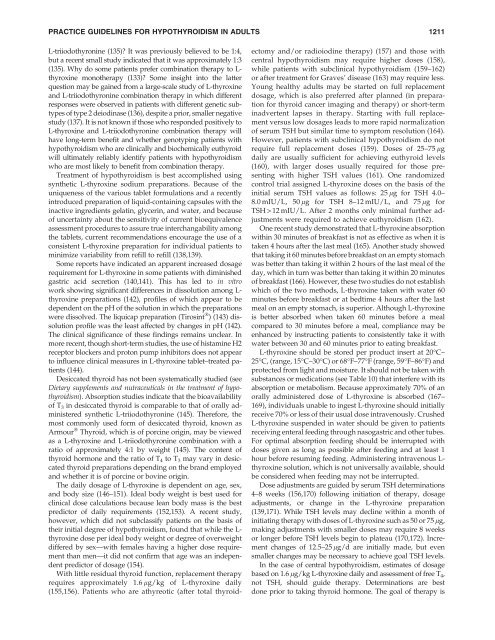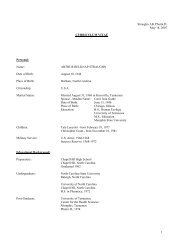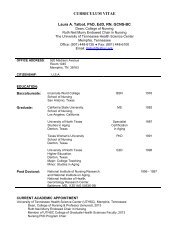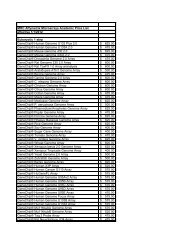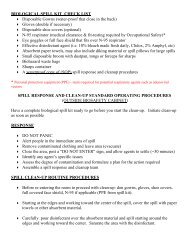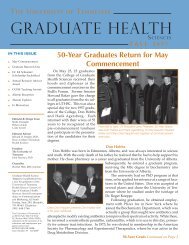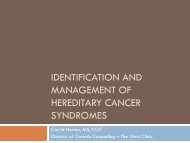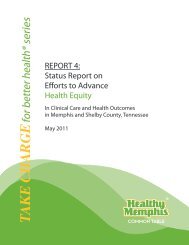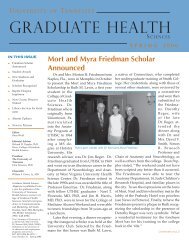Clinical Practice Guidelines for Hypothyroidism in Adults ...
Clinical Practice Guidelines for Hypothyroidism in Adults ...
Clinical Practice Guidelines for Hypothyroidism in Adults ...
You also want an ePaper? Increase the reach of your titles
YUMPU automatically turns print PDFs into web optimized ePapers that Google loves.
PRACTICE GUIDELINES FOR HYPOTHYROIDISM IN ADULTS 1211L-triiodothyron<strong>in</strong>e (135)? It was previously believed to be 1:4,but a recent small study <strong>in</strong>dicated that it was approximately 1:3(135). Why do some patients prefer comb<strong>in</strong>ation therapy to L-thyrox<strong>in</strong>e monotherapy (133)? Some <strong>in</strong>sight <strong>in</strong>to the latterquestion may be ga<strong>in</strong>ed from a large-scale study of L-thyrox<strong>in</strong>eand L-triiodothyron<strong>in</strong>e comb<strong>in</strong>ation therapy <strong>in</strong> which differentresponses were observed <strong>in</strong> patients with different genetic subtypesof type 2 deiod<strong>in</strong>ase (136), despite a prior, smaller negativestudy (137). It is not known if those who responded positively toL-thyrox<strong>in</strong>e and L-triiodothyron<strong>in</strong>e comb<strong>in</strong>ation therapy willhave long-term benefit and whether genotyp<strong>in</strong>g patients withhypothyroidism who are cl<strong>in</strong>ically and biochemically euthyroidwill ultimately reliably identify patients with hypothyroidismwho are most likely to benefit from comb<strong>in</strong>ation therapy.Treatment of hypothyroidism is best accomplished us<strong>in</strong>gsynthetic L-thyrox<strong>in</strong>e sodium preparations. Because of theuniqueness of the various tablet <strong>for</strong>mulations and a recently<strong>in</strong>troduced preparation of liquid-conta<strong>in</strong><strong>in</strong>g capsules with the<strong>in</strong>active <strong>in</strong>gredients gelat<strong>in</strong>, glycer<strong>in</strong>, and water, and becauseof uncerta<strong>in</strong>ty about the sensitivity of current bioequivalenceassessment procedures to assure true <strong>in</strong>terchangability amongthe tablets, current recommendations encourage the use of aconsistent L-thyrox<strong>in</strong>e preparation <strong>for</strong> <strong>in</strong>dividual patients tom<strong>in</strong>imize variability from refill to refill (138,139).Some reports have <strong>in</strong>dicated an apparent <strong>in</strong>creased dosagerequirement <strong>for</strong> L-thyrox<strong>in</strong>e <strong>in</strong> some patients with dim<strong>in</strong>ishedgastric acid secretion (140,141). This has led to <strong>in</strong> vitrowork show<strong>in</strong>g significant differences <strong>in</strong> dissolution among L-thyrox<strong>in</strong>e preparations (142), profiles of which appear to bedependent on the pH of the solution <strong>in</strong> which the preparationswere dissolved. The liquicap preparation (Tiros<strong>in</strong>t Ò ) (143) dissolutionprofile was the least affected by changes <strong>in</strong> pH (142).The cl<strong>in</strong>ical significance of these f<strong>in</strong>d<strong>in</strong>gs rema<strong>in</strong>s unclear. Inmore recent, though short-term studies, the use of histam<strong>in</strong>e H2receptor blockers and proton pump <strong>in</strong>hibitors does not appearto <strong>in</strong>fluence cl<strong>in</strong>ical measures <strong>in</strong> L-thyrox<strong>in</strong>e tablet–treated patients(144).Desiccated thyroid has not been systematically studied (seeDietary supplements and nutraceuticals <strong>in</strong> the treatment of hypothyroidism).Absorption studies <strong>in</strong>dicate that the bioavailabilityof T 3 <strong>in</strong> desiccated thyroid is comparable to that of orally adm<strong>in</strong>isteredsynthetic L-triiodothyron<strong>in</strong>e (145). There<strong>for</strong>e, themost commonly used <strong>for</strong>m of desiccated thyroid, known asArmour Ò Thyroid, which is of porc<strong>in</strong>e orig<strong>in</strong>, may be viewedas a L-thyrox<strong>in</strong>e and L-triiodothyron<strong>in</strong>e comb<strong>in</strong>ation with aratio of approximately 4:1 by weight (145). The content ofthyroid hormone and the ratio of T 4 to T 3 may vary <strong>in</strong> desiccatedthyroid preparations depend<strong>in</strong>g on the brand employedand whether it is of porc<strong>in</strong>e or bov<strong>in</strong>e orig<strong>in</strong>.The daily dosage of L-thyrox<strong>in</strong>e is dependent on age, sex,and body size (146–151). Ideal body weight is best used <strong>for</strong>cl<strong>in</strong>ical dose calculations because lean body mass is the bestpredictor of daily requirements (152,153). A recent study,however, which did not subclassify patients on the basis oftheir <strong>in</strong>itial degree of hypothyroidism, found that while the L-thyrox<strong>in</strong>e dose per ideal body weight or degree of overweightdiffered by sex—with females hav<strong>in</strong>g a higher dose requirementthan men—it did not confirm that age was an <strong>in</strong>dependentpredictor of dosage (154).With little residual thyroid function, replacement therapyrequires approximately 1.6 lg/kg of L-thyrox<strong>in</strong>e daily(155,156). Patients who are athyreotic (after total thyroidectomyand/or radioiod<strong>in</strong>e therapy) (157) and those withcentral hypothyroidism may require higher doses (158),while patients with subcl<strong>in</strong>ical hypothyroidism (159–162)or after treatment <strong>for</strong> Graves’ disease (163) may require less.Young healthy adults may be started on full replacementdosage, which is also preferred after planned (<strong>in</strong> preparation<strong>for</strong> thyroid cancer imag<strong>in</strong>g and therapy) or short-term<strong>in</strong>advertent lapses <strong>in</strong> therapy. Start<strong>in</strong>g with full replacementversus low dosages leads to more rapid normalizationof serum TSH but similar time to symptom resolution (164).However, patients with subcl<strong>in</strong>ical hypothyroidism do notrequire full replacement doses (159). Doses of 25–75 lgdaily are usually sufficient <strong>for</strong> achiev<strong>in</strong>g euthyroid levels(160), with larger doses usually required <strong>for</strong> those present<strong>in</strong>gwith higher TSH values (161). One randomizedcontrol trial assigned L-thyrox<strong>in</strong>e doses on the basis of the<strong>in</strong>itial serum TSH values as follows: 25 lg <strong>for</strong> TSH 4.0–8.0 mIU/L, 50 lg <strong>for</strong> TSH 8–12 mIU/L, and 75 lg <strong>for</strong>TSH > 12 mIU/L. After 2 months only m<strong>in</strong>imal further adjustmentswere required to achieve euthyroidism (162).One recent study demonstrated that L-thyrox<strong>in</strong>e absorptionwith<strong>in</strong> 30 m<strong>in</strong>utes of breakfast is not as effective as when it istaken 4 hours after the last meal (165). Another study showedthat tak<strong>in</strong>g it 60 m<strong>in</strong>utes be<strong>for</strong>e breakfast on an empty stomachwas better than tak<strong>in</strong>g it with<strong>in</strong> 2 hours of the last meal of theday, which <strong>in</strong> turn was better than tak<strong>in</strong>g it with<strong>in</strong> 20 m<strong>in</strong>utesof breakfast (166). However, these two studies do not establishwhich of the two methods, L-thyrox<strong>in</strong>e taken with water 60m<strong>in</strong>utes be<strong>for</strong>e breakfast or at bedtime 4 hours after the lastmeal on an empty stomach, is superior. Although L-thyrox<strong>in</strong>eis better absorbed when taken 60 m<strong>in</strong>utes be<strong>for</strong>e a mealcompared to 30 m<strong>in</strong>utes be<strong>for</strong>e a meal, compliance may beenhanced by <strong>in</strong>struct<strong>in</strong>g patients to consistently take it withwater between 30 and 60 m<strong>in</strong>utes prior to eat<strong>in</strong>g breakfast.L-thyrox<strong>in</strong>e should be stored per product <strong>in</strong>sert at 20°C–25°C, (range, 15°C–30°C) or 68°F–77°F (range, 59°F–86°F) andprotected from light and moisture. It should not be taken withsubstances or medications (see Table 10) that <strong>in</strong>terfere with itsabsorption or metabolism. Because approximately 70% of anorally adm<strong>in</strong>istered dose of L-thyrox<strong>in</strong>e is absorbed (167–169), <strong>in</strong>dividuals unable to <strong>in</strong>gest L-thyrox<strong>in</strong>e should <strong>in</strong>itiallyreceive 70% or less of their usual dose <strong>in</strong>travenously. CrushedL-thyrox<strong>in</strong>e suspended <strong>in</strong> water should be given to patientsreceiv<strong>in</strong>g enteral feed<strong>in</strong>g through nasogastric and other tubes.For optimal absorption feed<strong>in</strong>g should be <strong>in</strong>terrupted withdoses given as long as possible after feed<strong>in</strong>g and at least 1hour be<strong>for</strong>e resum<strong>in</strong>g feed<strong>in</strong>g. Adm<strong>in</strong>ister<strong>in</strong>g <strong>in</strong>travenous L-thyrox<strong>in</strong>e solution, which is not universally available, shouldbe considered when feed<strong>in</strong>g may not be <strong>in</strong>terrupted.Dose adjustments are guided by serum TSH determ<strong>in</strong>ations4–8 weeks (156,170) follow<strong>in</strong>g <strong>in</strong>itiation of therapy, dosageadjustments, or change <strong>in</strong> the L-thyrox<strong>in</strong>e preparation(139,171). While TSH levels may decl<strong>in</strong>e with<strong>in</strong> a month of<strong>in</strong>itiat<strong>in</strong>g therapy with doses of L-thyrox<strong>in</strong>e such as 50 or 75 lg,mak<strong>in</strong>g adjustments with smaller doses may require 8 weeksor longer be<strong>for</strong>e TSH levels beg<strong>in</strong> to plateau (170,172). Incrementchanges of 12.5–25 lg/d are <strong>in</strong>itially made, but evensmaller changes may be necessary to achieve goal TSH levels.In the case of central hypothyroidism, estimates of dosagebased on 1.6 lg/kg L-thyrox<strong>in</strong>e daily and assessment of free T 4 ,not TSH, should guide therapy. Determ<strong>in</strong>ations are bestdone prior to tak<strong>in</strong>g thyroid hormone. The goal of therapy is


